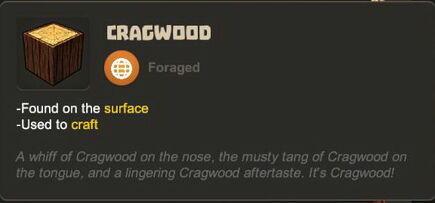
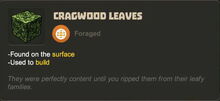
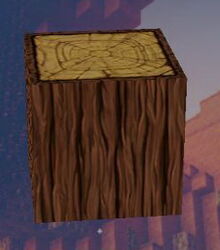
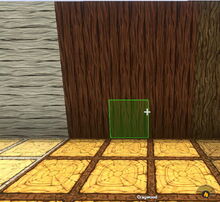
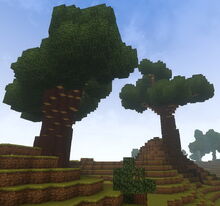
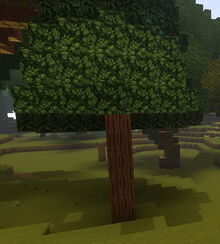
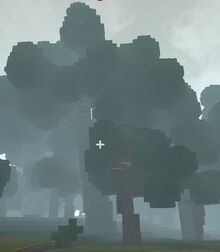
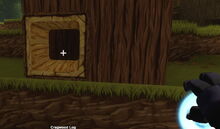
Cragwood is a block of Wood with auburn-brown bark and pale brown wooden core taken from a Cragwood-trees.
No Power Cells are required to pull / collect Wood (usually from trees) or Logs of any type (usually lying on the ground) except for Corrupted Wood - which can be found in large amounts on the Corruption layer, but on some gameworlds also rarely hovers over the surface in the shape of slightly bent stems.
Blocks of Cragwood can also often be found in Wood Treasure Chests that occasionally spawn in complete darkness during the night on surface blocks, and Stone Treasure Chests that can spawn during day and night in darkness on blocks of the Fossil layer in shallow Caves, like Bedrock. Currently (April 2017), ca. 45-90 blocks of Cragwood can be discovered in every third to fourth Wood Treasure Chest.
With a Plow equipped, blocks of Cragwood can be turned into Cragwood Logs since R40 in March 2017.
Harvesting or finding blocks of Cragwood is one of the unlocking requirements for the crafting recipe of Processors as of R40 in March 2017. While the crafting recipe itself accepts different types of Wood and Logs as an ingredience, only Cragwood and no other type of Wood will be sufficient to unlock the crafting recipe for the Processor as a first step.
Blocks of Cragwood as well as Cragwood Logs can be processed into Wood Slabs and/or into Wood Rods in a Processor, without requiring a crafting recipe.
Cragwood trees have dark green leaves and chestnut-brown barks; they can be seen in different sizes from small and bushlike to medium size to very large with 8x8 block-wide stems at its greatest height.
Cragwood trees are common in Forests, Woodlands and Grassland biomes. Smaller, bushlike versions of Cragwood can also be found in Savannahs or on top of rock formations of Canyons. Cragwood trees do not grow in other Biomes, however Cragwood Logs are still found in many, and also blocks of Cragwood (no other type of Wood) in randomly spawning Wood Treasure Chests at night.
"Giant" Cragwood trees can reach altitudes of ca. 180 with their tree tops, where the temperature is so low (ca. 10 "Creativerse" degrees or below) that you might even find a few blocks of Snow up there. When climbing trees like that, please note that your player character will start to freeze (starts at 28 "Creativerse" degrees) and can take deadly damage over time from freezing when the freezing meter/scale has filled with white color.
Usually Forests, Woodlands and Grasslands are rather safe from spreading forest-fires because of their mild temperature. However as all blocks of Wood and Leaves are well flammable, you might still want to take avoid placing torches or objects with open fire (like Campfires or Fire Pits) directly under such flammable blocks, especially in significantly warmer areas, as fire is able to spread there except on gameworlds and/or claims where the fire spreading option is disabled.
Yellow Flowers might grow on and amongst Leaves of Cragwood trees, and there are also often Beehives hiding in its treetop which are all part of the (one of 4 randomly chosen) original template worlds that each new gameworld is a copy of. Larger Cragwood-trees usually have patches of Vines covering on their trunks, however not as many Vines as Wildwood-trees in Jungles have growing on them and even hanging down from their foliage.
Cragwood trees can be grown by players by placing 1 Cragwood Sapling on blocks of green Grass with Water (or other liquids) nearby. However this will only lead to rather small and very slender trees.
Cragwood trees of somehow larger size and with thicker trunks (4 blocks) will grow when planting 4 Saplings together. But sometimes planting several Saplings together will only make thin Cragwood trees grow on top of each other.
Please note that trees cannot be grown everywhere. If Saplings are "fallow" (look at them right after placing them), they will not evolve into trees at all. Certain Biomes are unfitting to grow trees, the temperature of the environment might be too high or low, or too much Bog Water might be nearby. Additionally to that, player-grown Cragwood trees rarely might not have any Vines, Flowers and/or Beehives on them.
More Yellow Flowers and Queen Bees (that will quickly evolve into Beeswax by themselves in fitting environments) usually spawn by themselves on Cragwood Leaves later on (also on player-grown trees), especially on gameworlds with the "Pro" option "more regrowth" enabled. Vines cannot "regrow" though (but you can collect them by hunting and/or pet-harvesting Leafies of many kinds).
Beehives made of Beeswax can also be grown by planting Queen Bees (an occasional additional harvest when collecting Beeswax) on Cragwood blocks and/or blocks of Cragwood Leaves. Just like Saplings, Queen Bees too can stay fallow if planted in unfitting environments.
Unprocessed Cragwood can be used to craft a number of recipes in the Crafting Menu (default key "Q") or at any Crafting Table (that might still exist in older worlds created before September 2015), like Wood Swords, Moss Torches, Wood Walls, Wood Chests, Wood Doors and many others. Most of these crafting recipes will also accept other types of Wood though by clicking on the Wood icon that has two blue arrows on it after choosing the according crafting recipe from the Crafting Menu.
Cragwood (2 blocks each) and also Cragwood Leaves (4 blocks each) can be used as Fuel for Forges too, however both of them belong to the slowest burning type of Fuel. Currently (April 2017), it is more economical though to first process blocks of Wood into Wood Rods in the Processor to be used as Fuel, as each melting/hardening process in the Forge will use up only 8 Wood Rods that can be made from 1 block of Wood.
Cragwood can be corrupted easily; and it is not necessary to waste Corrupt Bombs for this. Simply place one corrupted block, for example Corrupted Wood, next to a block of Cragwood, and such the Wood will quickly corrupt. Corrupt Obelisks will have the same effect. Corrupted blocks or Corrupted Water adjacent Cragwood-blocks into Corrupted Wood. In such a way, Corruption will spread from one block of Wood to the next, and over time, all Wood blocks (of any kind) that have touched each other will corrupt, until in the end all of the Wood of a tree will have turned into Corrupted Wood (but no Leaves nor other blocks will be corrupted by this).
Corrupted Wood can only picked up with a Diamond Mining Cell or Lumite Mining Cell equipped, which makes both Power Cells lose durability in the process. Also, corrupted blocks like Corrupted Wood placed in the gameworld can make corrupted Creatures and also Diamond Treasure Chests spawn in darkness.
However, Corrupted Wood is a good Fuel that lets the Forge work much faster than common uncorrupted Wood blocks. Still, 2 blocks of Corrupted Wood will be used up for each smelting/hardening at a time, and you cannot process Corrupted Wood to any Slabs nor Rods.
Cragwood Leaves can be corrupted too, however only by throwing Corrupt Bombs. This will also make both of them into Fuel of much higher quality (4 Corrupted Leaves at a time for each process) and can make corrupted Creatures and also Diamond Treasure Chests spawn in darkness just as well. Corrupted Leaves cannot be processed to Shredded Leaves in the Processor.
If you purify Corrupted Wood (as well as already Corrupted Leaves) that you find on the Corruption layer by placing Healing Beacons or throwing Purification Bombs, they will turn into Cragwood (and Cragwood Leaves).
However, also many blocks of Wood - Parchwood, Wildwood, Weepwood, Autumnwood, Shorewood - will turn into Corrupted Wood by corrupting them, and when puryfied, they will then ALL turn into Cragwood. The same goes for their Leaves. Only Ashenwood, Elderwood and their leaves are unique and such will transform into specific corrupted versions (and back again), at least by name.
